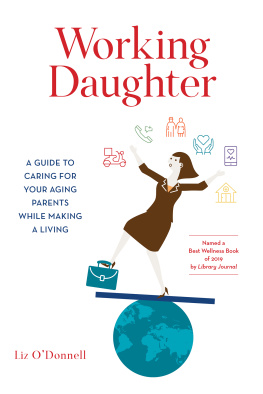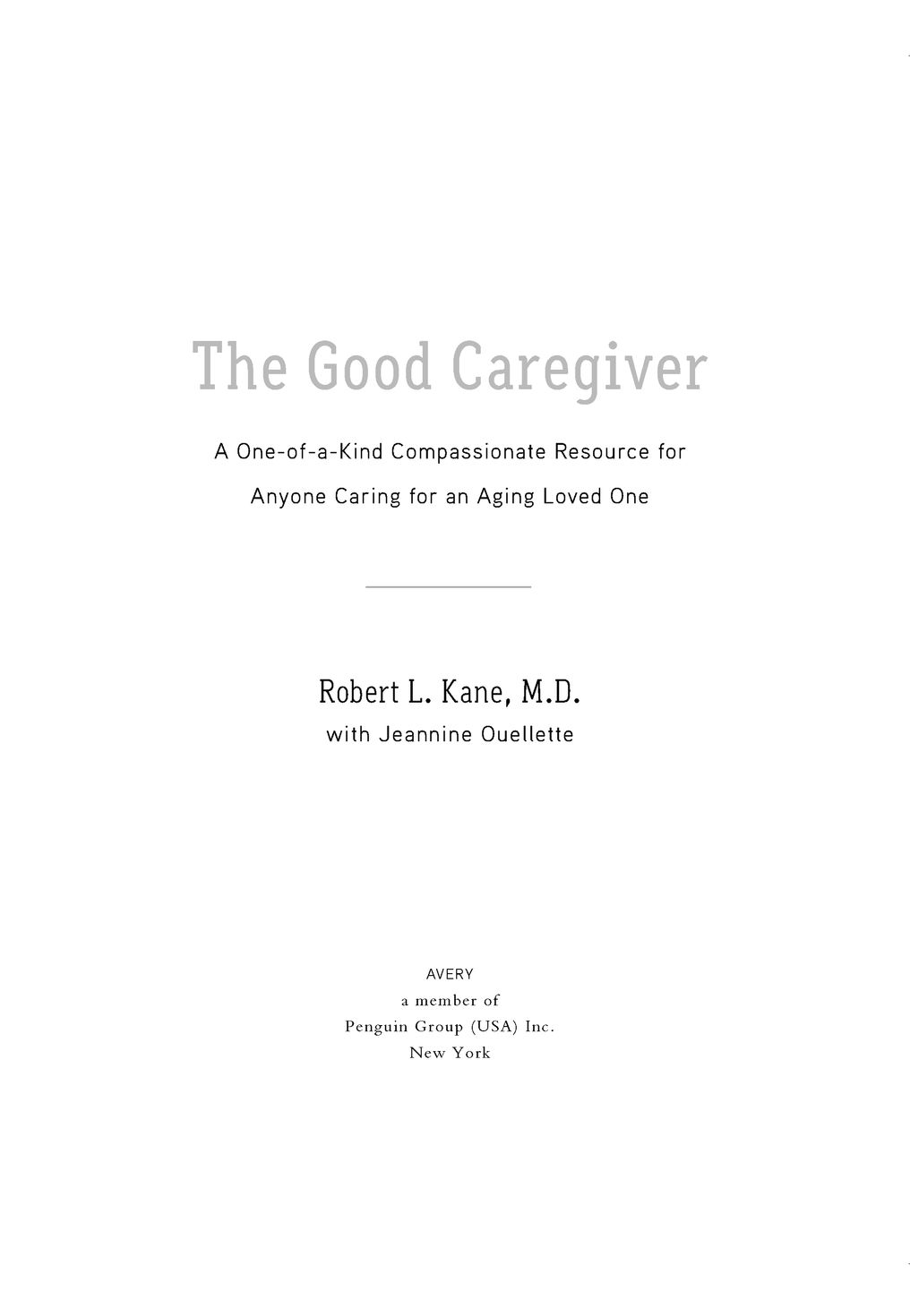Table of Contents
To my sister, Candy,
who taught me what caring was really about
Introduction
The Good Caregiver
Lessons Learned from a Broken System
Long-term care... affects a large portion of the population, it is expensive (it currently accounts for about 10 percent of all health care costs), and it requires a unique partnership between government and citizens. Moreover, a range of constituencies perceive the current long-term care system as seriously broken. It exposes people who need services to considerable financial risk, and it too often relies on an institutional model of care that is at odds with consumer preferences.
David G. Stevenson, Ph.D.,
The New England Journal of Medicine, May 8, 2008
We dont think about long-term care until it hits us in the face. But avoidance is no defense. The average American who lives to age sixty-five has about a 40 percent chance of spending time in a nursing home. As former first lady Rosalynn Carter once said, There are only four kinds of people in this world: Those who have been caregivers; those who currently are caregivers; those who will be caregivers; and those who will need caregivers. Nearly all of us will have to deal with long-term care either for ourselves or for parents, relatives, friends, or neighbors. But if long-term care is an inescapable consequence of a longer-lived society, why dont we prepare for it?
Partly, it is because we dont get many chances to practice. Except for jokes about it, old age isnt a common dinner party topic. Elder care, dementia, and death arent things we normally chat about. Even if we did want to educate ourselves, we arent sure where to turn for sound information or advice. And most of us dont think that far ahead. We rarely read instruction manuals for new appliances unless we cant get the damn things to work. What we usually want is a good index that will direct us to solutions for problems as they arise. That is what this book is designed to do.
Prepare to Care
From the very start, you will need to assess your own or your familys ability to provide care. Chapter One, Becoming a Caregiver, includes a helpful quiz to get you started in assessing your areas of strength and weakness as a care provider. The quiz can also help you identify if youre just not cut out to handle the demands of being a caregiver. Not everyone has the temperament or resources for long-term caregiving. Caregiving is hard and demanding work, but there are lifelong rewards. You will form special relationships in intensely personal and meaningful ways. You will make the lives of people you love immeasurably better. Many, many caregivers speak powerfully to the multiple ways caring for a loved one enriched their own lives and provided a lasting and indelible sense of purpose and meaning.
A Balanced View
In The Good Caregiver, I present a balanced view of caregiving, but I do not pull any punches. You will find truthful accounts and practical advice about a world that most people have never before encountered until they find themselves in the middle of it. But youll also get a glimpse through the usually covered window of long-term caregiving for the elderly, a world where the demands are intense, yes, but where the bonds of love and the memories of powerful shared experience with a loved one at lifes most vulnerable juncture can be profoundly transformative.
GIFTS AND LESSONS OF CAREGIVING
The realization that the finite nature of our human lives is a gift. This realization is a compelling motivator not to put off ones dreams, not to stand for a life that is not being fully lived.
The deepening of faith. Faith not necessarily as religion, but as a deeper spiritual connection to the force of life that is universal and enduring.
The reconnection with siblings. Although sibling relationships are often strained in the face of the stress of dealing with a dying parent and perhaps also with unresolved issues of childhood, siblings may get closer and communicate positively and affirm each other more.
The wonder of friends. My friends concern and small acts of kindness for my mother and for me constituted a beautiful gift.
The (growing) ability to say no. I had to say no to many things. Some I was fine with; other things were very difficult.
The up close and personal view of why it is important to make plans for aging or declining years. I now understand how important it is to (1) downsize ones material possessions and home; (2) understand ones own social and support network; (3) adapt ones living space for an aging body; and (4) put aside money to serve as a home-based services fund and/or for purchasing long-term care insurance.
The growing awareness to invest more time on ones own physical health. This means the right food, the right exercise, the right sleep.
A greater ability to not sweat the small stuff.
The appreciation of relationships, especially with the person who is in need.
The awareness of the importance of humor. This comes often by finding the lighter side of a dark event.
DEB PAONE, CAREGIVING DAUGHTER
How to Use This Book as an Instruction Manual
Most people facing the caregiving role are neophytes. They have never experienced such a challenge before. Knowing how to respond to the nitty-gritty realities of caring for an older person doesnt usually come automatically. New caregivers need a staggering amount of honest, straightforward advice on the nuts and bolts of managing care for a loved one. They need straight talk about the behind-the-scenes tasks that can make a lasting impact on the quality of the caregiving experience for everyone involved. Most people even need step-by-step instructions on handling some of the hands-on caregiving tasks that an older person will need. How do you assist a frail elderly person with bathing? What is the best (and worst) way to deal with urinary incontinence? Is there a simple, safe way to keep track of multiple prescriptions? No one is born knowing the ins and outs of caregiving! Few want to take a course in it.
Ideally, people coming new to caregiving would stop and read the instruction manual from cover to cover. But in my experience, whenever I get a new device with clear instructions to read the whole manual before attempting to operate it, I never do. In fact, I know very few people who do. What most of us want is a good index where we can turn when we run into a problem. This book was written and organized to be used for just that purpose, to be consulted as a resource and guide in the manner that best suits your needs as they arise.
So if you have just found yourself thrown into the role of caregiver, with practically no warning or preparation, you can use this book like the instruction manual for that appliance that would not turn on; just go straight to the chapter that deals with the issue youre trying to deal with right now. For example, the nursing home calls to tell you that Mom has some troubling symptoms and is being sent to the emergency room. Before you jump in the car to meet her there (and you should do just that, if you live nearby and are able to), you should review the section on Emergency Rooms in Chapter Eight: Handling Hospitals. Or, maybe there have been some warning signs that are causing you to worry about the safety of your parents driving. Chapter Five: Daily Life includes everything you need to know about when and how to break the news to Mom or Dad about the end of driving (and you may be surprised that it is often better if you are not the one to deliver this sensitive message). Whether your question is about guardianship, nutrition, adult day care, or hospice, you can use the index at the back of this book to take you straight to the chapters and pages that will answer your immediate questions.








